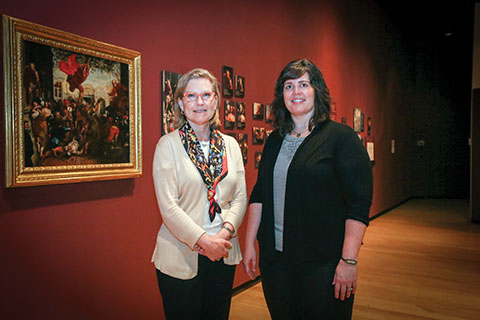Art & Science
Muscarelle Museum of Art chief curator identifies Czanne painting
October 1, 2017
By
Joseph McClain
and
Jennifer L. Williams

John Spike, chief curator at the Muscarelle Museum of Art, knew he was looking at a Cézanne.
Analysis and testing of the painting “The Miracle of the Slave” have backed up his now certainty that it was painted by French artist Paul Cézanne as a copy of an original work from 300 years earlier.
Italian Renaissance artist Jacopo “Tintoretto” Robusti painted the original in 1548. It is referred to as “The Miracle of the Slave” or the “Miracle of St. Mark Freeing the Slave,” and depicts the story of St. Mark saving a slave who was being punished for worshipping.
The original is a much larger work, with Cézanne’s copy a smaller reproduction. The reproduction was unattributed when it went up for auction at the Dorotheum auction house in Vienna, Austria, in 2013.
“I saw it and I realized that it was a Cézanne of his earliest experimental juvenile period, the latter 1860s,” says Spike, who is one of the world’s most recognized connoisseurs of Old Master paintings.
He alerted Muscarelle director Aaron De Groft ’88 and they went to look at the painting. They were sure it was a Cézanne before deciding to purchase it for the museum.
Spike is able to identify artists by knowing their work, including everything from exactly how they built up paint layers to subtleties in shading and shape, he said.
Spike pointed out subtle changes Cézanne made to his work compared to the original, including appearing to paint his uncle’s likeness onto the face of a character whose visage isn’t visible in the original. The face bears a striking similarity to portraits Cézanne painted of his uncle Dominique.
Similarities typical of Cézanne’s work of the 1860s, including “noodle noses,” darkened eyes and thicker globs of paint, also are present.
Cézanne frequently stated his passionate admiration for Tintoretto’s works and considered him his favorite artist, according to De Groft.
But there is also a scientific aspect, and De Groft and Spike decided that for this particular painting it would be worthwhile to do the full battery of tests, including X-rays and infrared paint testing.
Kristin Wustholz, an associate professor of chemistry at W&M, said that scientific examination found no basis to doubt Spike’s connoisseurship. She noted that science more often challenges — rather than confirms — an attribution of a painting. In the case of “The Miracle of the Slave,” though, science was able to add an arrow to Spike’s quiver.
Wustholz has been working in a seven-year partnership with Shelley Svoboda, senior conservator of paintings at the Colonial Williamsburg Foundation. They have refined and advanced a technique for identifying pigments in historic paintings and other artifacts.
The Svoboda-Wustholz technique uses SERS — surface enhanced Raman spectroscopy. It’s a minimally destructive technique that requires only the smallest sample and it is the state-of-the-art process for identifying a synthetic organic pigment.
The presence of the unusual pigment mauveine was the “most amazing and surprising thing,” Spike says.
Scientists have pinpointed that mauveine was produced between 1856 and 1869 only, during which time Cézanne would have been between the ages of 17 and 30. He would have been in his early romantic period, and copying the works of other artists at that time, according to Spike.